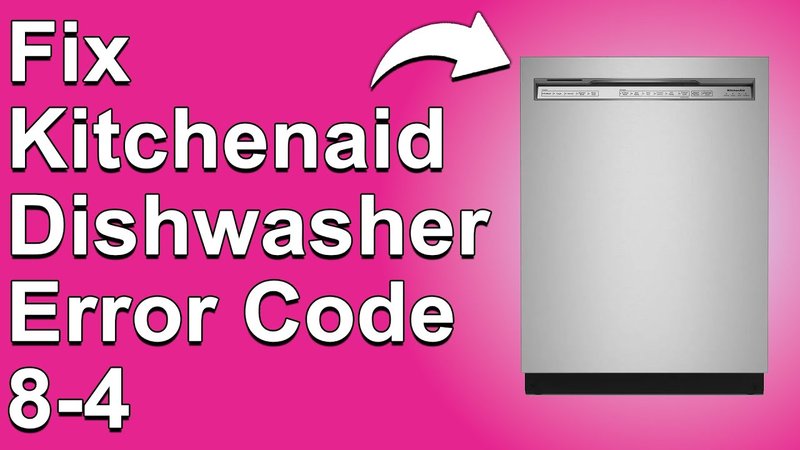
The “OE” error code indicates a drainage issue with your dishwasher. Imagine trying to empty a bathtub with a blocked drain. It’s not going to work effectively, and over time, it leads to a mess. Similarly, when your dishwasher can’t drain properly, the error code pops up as a distress signal. But don’t worry, I’ll guide you through understanding why this happens and how you can prevent it to keep your kitchen running like a well-oiled machine. Let’s dive in!
Understanding the “OE” Error Code
First things first: what exactly does the “OE” error signify? Simply put, this code is your dishwasher’s way of telling you there’s a drainage problem. Imagine if your dishwasher’s drain line was its throat, and the water is the voice trying to be heard. If the line is clogged or obstructed, the water can’t be “heard,” and so the error code starts flashing.
The common causes of a clogged drain line can include food debris build-up, grease accumulation, or even foreign objects. Picture your dishwasher’s drain as a busy highway; when there’s a traffic jam, nothing moves, right? Similarly, when debris piles up, it creates a blockage preventing water from draining away. The outcome? You see that pesky “OE” code, and your dishes remain wet and dirty.
To clear this problem, you must ensure your drain line is clear. Regular cleaning and maintenance can prevent these blockages from happening. Much like you wouldn’t let your car go without an oil change, your dishwasher needs occasional attention to avoid problems down the road.
Regular Maintenance: Your Best Defense
You might be wondering, “How often should I maintain my dishwasher to prevent the ‘OE’ error?” Consistent maintenance is key. Think of your dishwasher as a plant needing water and sunlight. Neglect it, and it withers; care for it, and it thrives. Regular upkeep ensures smooth operation and prevents minor issues from becoming major headaches.
Start by checking and cleaning the filter. This component traps food particles, and if left unchecked, it can become a hotspot for clogs. Remove it according to your Kitchenaid model’s manual and rinse it under warm water, gently scrubbing away any stuck debris. It’s like brushing your teeth to prevent cavities – simple yet effective.
Next, inspect the drain hose for kinks or clogs. The hose is like your dishwasher’s plumbing system, and any blockage can lead to drainage issues. Detach it as described in your manual, then flush it with water to ensure it’s clear. This process is akin to using a drain cleaner to keep your sink flowing smoothly.
Proactive Cleaning Habits
Here’s a tip: adopt proactive cleaning habits to keep that error code at bay. Much like preventive medicine, these habits can stop problems before they start. For instance, scrape off excess food from dishes before placing them in the dishwasher. This simple step reduces the amount of debris that ends up in your filter and drain.
Additionally, running an empty cycle with a cup of vinegar once a month can help dissolve grease and break down food particles that might be causing minor build-ups. It’s like giving your dishwasher a gentle cleanse, ensuring it remains sparkling clean and odor-free.
Finally, periodically check the garbage disposal (if your dishwasher is connected to it) to ensure it’s not the source of the blockage. A visit to the disposal is like checking the root of the tree; if it’s blocked, it affects everything upstream.
Long-term Prevention Strategies
Preventing the “OE” error in the future is all about creating a sustainable maintenance routine. Much like adopting a healthy lifestyle to prevent illness, these long-term strategies can keep your dishwasher in top shape. Start by scheduling bi-annual professional check-ups. Just like you visit your doctor for a health check, your dishwasher benefits from expert care to spot potential issues early.
Investing in a high-quality water softener can also be beneficial if you have hard water. Hard water can lead to mineral build-up, which, over time, might contribute to drainage problems. Think of it like using a water purifier to ensure you’re drinking the cleanest water; the same concept applies to your dishwasher.
Lastly, make it a habit to listen to your appliance. If it starts making unusual noises or not functioning as efficiently, don’t ignore it. Much like your car, strange sounds or behaviors are a cry for help. Addressing these signs early can prevent the problem from escalating to that dreaded error code.
By following these detailed steps and adopting these habits, you’re not only preventing the “OE” error code but also extending the lifespan of your beloved Kitchenaid dishwasher. Remember, a little effort now can save you a lot of hassle later on, keeping your kitchen running smoothly like clockwork.